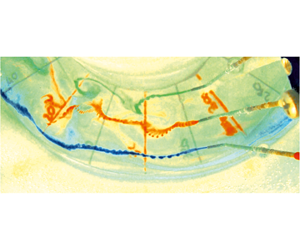Article contents
Buoyancy transfer in a two-layer system in steady state. Experiments in a Taylor–Couette cell
Published online by Cambridge University Press: 08 June 2020
Abstract

Our experimental study focuses on the density and velocity field in two layers of fluid separated by a sharp density interface. Turbulence is generated by a non-invasive stirrer, a Taylor–Couette tank, and the interface is stabilized with a source of saline fluid and a source of fresh water at the bottom and top of the tank, respectively. The same volume fluxes are withdrawn by two sinks to maintain a constant volume of fluid in the tank. Our results confirm past experiments and show that a strong vertical exchange of fluid occurs close to the inner cylinder and across the interface, where the vertical turbulent length scales appear to be suppressed. For low values of kinetic energy supplied to the system, the interface may act as a rigid boundary for the turbulent eddies, with a reduction of the vertical length scales although it seems not to affect the horizontal length scales. The vertical buoyancy flux extracted at the top of the tank is fairly well reproduced by the measured correlation  $\overline{\unicode[STIX]{x1D70C}^{\prime }w^{\prime }}$ between density and vertical velocity fluctuations across the interface. Quadrant analysis of the correlation terms reveals that the greatest contribution to salt flux is given by eddies that carry the lighter fluid from top to bottom across the interface. The mixing process is accompanied by a single wake-like disturbance, with a radial front advancing in the azimuthal direction across the interface, acting as a blade, and with a period that decreases with rotation rate. The wake favours the smoothing of the density step and, in a simplified model, we assume that the turbulent diffusion is active during a fraction of the cycle in the wake-mixing region, with diffusivity proportional to the transverse length scale and the speed of the wake. The mixing region is the domain between the nose of the wave-like perturbation and the section where the interface becomes ‘darker’ again after being mixed by the vortexes. The results of this model are in a fair agreement with the experiments. The potential energy of the interfacial perturbations is only a small part of the missing turbulent kinetic energy, defined as the difference in the turbulent kinetic energy between a well-mixed fluid and a two-layer fluid. Further analysis is needed to explain the mechanism of generating these perturbations and the factors that control their periodicity.
$\overline{\unicode[STIX]{x1D70C}^{\prime }w^{\prime }}$ between density and vertical velocity fluctuations across the interface. Quadrant analysis of the correlation terms reveals that the greatest contribution to salt flux is given by eddies that carry the lighter fluid from top to bottom across the interface. The mixing process is accompanied by a single wake-like disturbance, with a radial front advancing in the azimuthal direction across the interface, acting as a blade, and with a period that decreases with rotation rate. The wake favours the smoothing of the density step and, in a simplified model, we assume that the turbulent diffusion is active during a fraction of the cycle in the wake-mixing region, with diffusivity proportional to the transverse length scale and the speed of the wake. The mixing region is the domain between the nose of the wave-like perturbation and the section where the interface becomes ‘darker’ again after being mixed by the vortexes. The results of this model are in a fair agreement with the experiments. The potential energy of the interfacial perturbations is only a small part of the missing turbulent kinetic energy, defined as the difference in the turbulent kinetic energy between a well-mixed fluid and a two-layer fluid. Further analysis is needed to explain the mechanism of generating these perturbations and the factors that control their periodicity.
JFM classification
- Type
- JFM Papers
- Information
- Copyright
- © The Author(s), 2020. Published by Cambridge University Press
References
- 8
- Cited by


